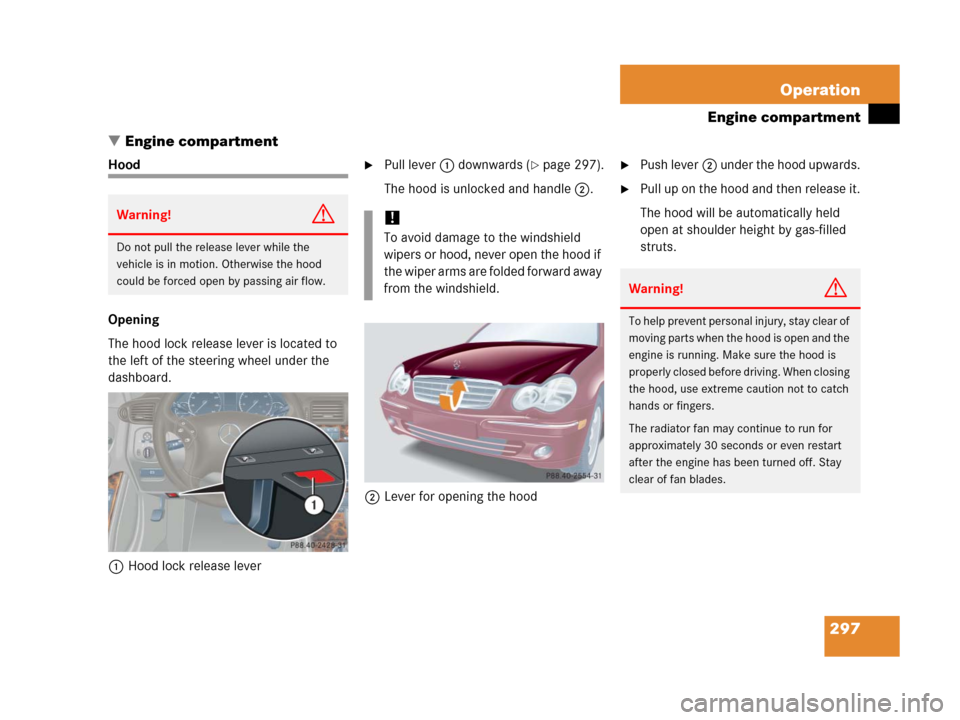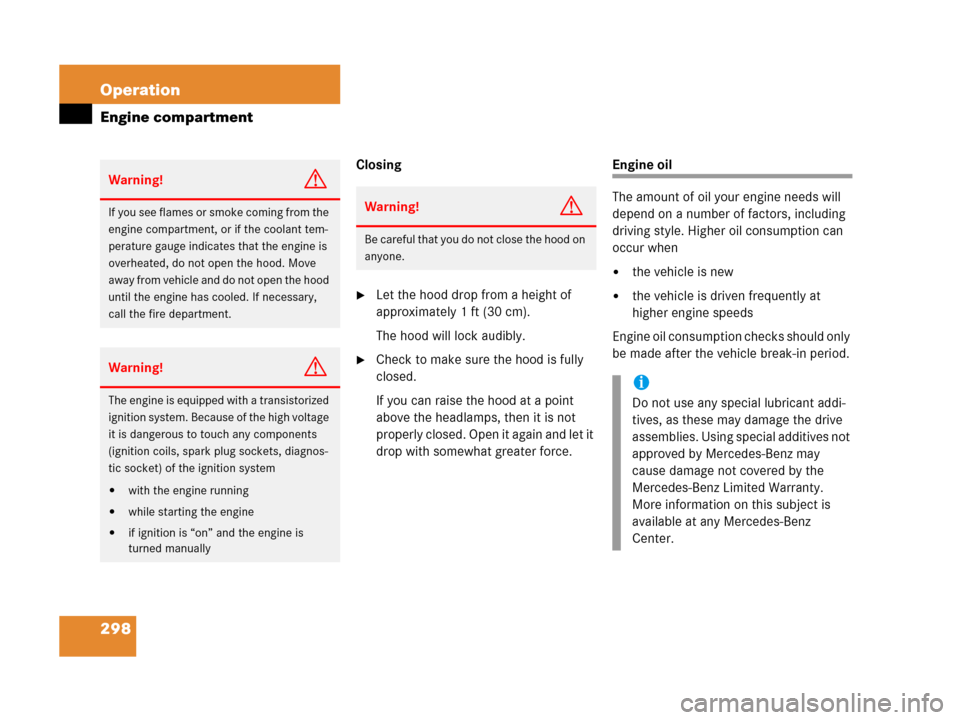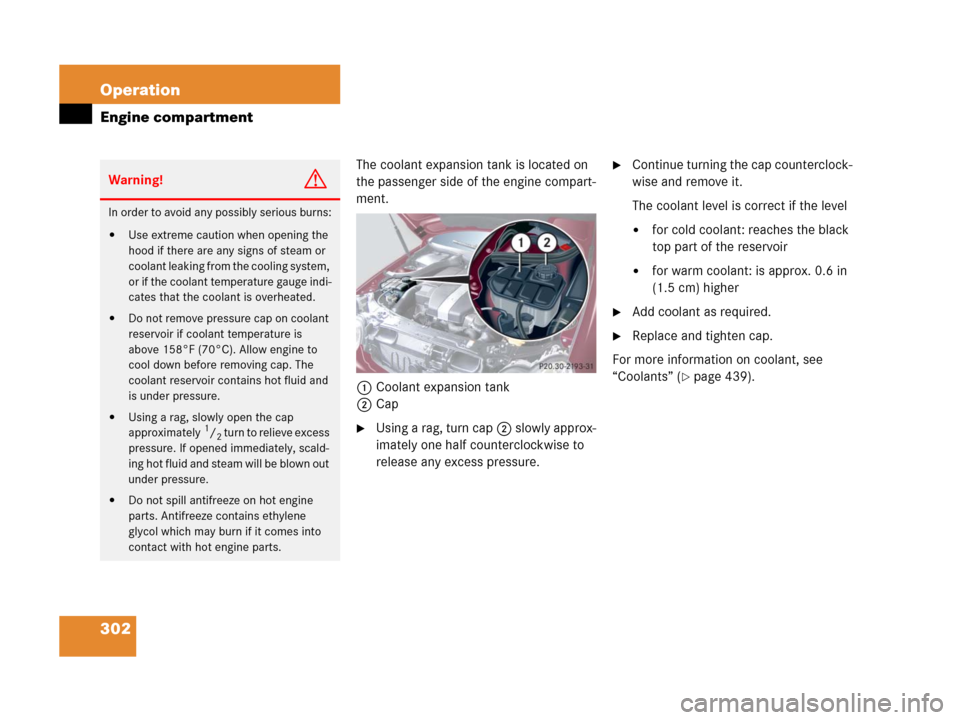Page 296 of 473

295 Operation
At the gas station
Coolant
For normal replenishing, use water (pota-
ble water quality). For more information,
see “Coolant level” (
�page 301) and
“Fuels, coolants, lubricants, etc.”
(
�page 436).
Brake fluid
Removing fuse box cover (
�page 421).Windshield washer and headlamp
cleaning system*
For more information on filling up the
washer reservoir, see “Windshield washer
system and headlamp cleaning system*”
(
�page 304).
Engine oil level
For more information on engine oil level,
see “Engine oil” (
�page 298).Vehicle lighting
Check function and cleanliness. For more
information on replacing light bulbs, see
“Replacing bulbs” (
�page 394).
Exterior lamp switch (
�page 114).
!
If you find that the brake fluid in the
brake fluid reservoir has fallen to the
minimum mark or below, have the
brake system checked for brake pad
thickness and leaks immediately.
Notify an authorized Mercedes-Benz
Center immediately. Do not add brake
fluid as this will not solve the problem.
For more information, see “Practical
hints” (
�page 351).
Page 298 of 473

297 Operation
Engine compartment
�Engine compartment
Hood
Opening
The hood lock release lever is located to
the left of the steering wheel under the
dashboard.
1Hood lock release lever�Pull lever1 downwards (�page 297).
The hood is unlocked and handle2.
2Lever for opening the hood�Push lever2 under the hood upwards.
�Pull up on the hood and then release it.
The hood will be automatically held
open at shoulder height by gas-filled
struts.
Warning!G
Do not pull the release lever while the
vehicle is in motion. Otherwise the hood
could be forced open by passing air flow.
!
To avoid damage to the windshield
wipers or hood, never open the hood if
the wiper arms are folded forward away
from the windshield.
Warning!G
To help prevent personal injury, stay clear of
moving parts when the hood is open and the
engine is running. Make sure the hood is
properly closed before driving. When closing
the hood, use extreme caution not to catch
hands or fingers.
The radiator fan may continue to run for
approximately 30 seconds or even restart
after the engine has been turned off. Stay
clear of fan blades.
Page 299 of 473

298 Operation
Engine compartment
Closing
�Let the hood drop from a height of
approximately 1 ft (30 cm).
The hood will lock audibly.
�Check to make sure the hood is fully
closed.
If you can raise the hood at a point
above the headlamps, then it is not
properly closed. Open it again and let it
drop with somewhat greater force.
Engine oil
The amount of oil your engine needs will
depend on a number of factors, including
driving style. Higher oil consumption can
occur when
�the vehicle is new
�the vehicle is driven frequently at
higher engine speeds
Engine oil consumption checks should only
be made after the vehicle break-in period.
Warning!G
If you see flames or smoke coming from the
engine compartment, or if the coolant tem-
perature gauge indicates that the engine is
overheated, do not open the hood. Move
away from vehicle and do not open the hood
until the engine has cooled. If necessary,
call the fire department.
Warning!G
The engine is equipped with a transistorized
ignition system. Because of the high voltage
it is dangerous to touch any components
(ignition coils, spark plug sockets, diagnos-
tic socket) of the ignition system
�with the engine running
�while starting the engine
�if ignition is “on” and the engine is
turned manually
Warning!G
Be careful that you do not close the hood on
anyone.
i
Do not use any special lubricant addi-
tives, as these may damage the drive
assemblies. Using special additives not
approved by Mercedes-Benz may
cause damage not covered by the
Mercedes-Benz Limited Warranty.
More information on this subject is
available at any Mercedes-Benz
Center.
Page 300 of 473

299 Operation
Engine compartment
Checking engine oil level with the
control system
When checking the oil level
�the vehicle must be parked on level
ground
�with the engine at operating tempera-
ture, the vehicle must have been
stationary for at least 5 minutes with
the engine turned off
�with the engine not at operating tem-
perature yet, the vehicle must have
been stationary for at least 30 minutes
with the engine turned off
To check the engine oil level via the
multifunction display, do the following:
�Switch on the ignition (�page 33).
The standard display (
�page 125) should
appear in the multifunction display.
�Press buttonk orj on the
multifunction steering wheel until the
following message is seen in the multi-
function display:One of the following messages will
subsequently appear in the multifunc-
tion display:
�Engine oil
level
OK
�Add 1.0 qt engine oil
for max. oil level
(Canada: 1.0 l)
�Add 1.5 qts engine oil
for max. oil level
(Canada: 1.5 l)
�Add 2.0 qts engine oil
for max. oil level
(Canada: 2.0 l)
�If necessary, add engine oil.
For adding engine oil, see (
�page 300).
For more information on engine oil, see the
“Technical data” section (
�page 436) and
(
�page 437).
Other display messages
If the SmartKey is not turned to position2
in the starter switch, the following
message will appear:
Switch ignition on to
check engine oil level
�Switch on the ignition (�page 33).
i
If you want to interrupt the checking
procedure, press thek orj
button on the multifunction steering
wheel.
Page 301 of 473

300 Operation
Engine compartment
If you see the message:
Observe waiting time
�If engine is at operating temperature,
wait 5 minutes before repeating check
procedure.
�If engine is not at operating tempera-
ture yet, wait 30 minutes before
repeating check procedure.
If you see the message:
Engine oil level
Not when engine on
�Turn off the engine.
�If the engine is at operating tempera-
ture, wait 5 minutes before checking
oil.
�If the engine is not at operating temper-
ature yet, you must wait 30 minutes
before checking oil.If there is excess engine oil with the engine
at operating temperature, the following
message will appear:
Engine oil level
Reduce oil level
�Have excess oil siphoned or drained
off. Contact an authorized
Mercedes-Benz Center.
For more information on messages in the
multifunction display concerning engine
oil, see the “Practical hints” section
(
�page 371) and (�page 372).Adding engine oil
!
Excess oil must be siphoned or drained
off. It could cause damage to the
engine and catalytic converter not
covered by the Mercedes-Benz Limited
Warranty.
!
Only use approved engine oils and oil
filters required for vehicles with
Maintenance System (U.S. vehicles) or
FSS (Canada vehicles). For a listing of
approved engine oils and oil filters,
refer to the Factory Approved Service
Products pamphlet in your vehicle
literature portfolio, or contact an
authorized Mercedes-Benz Center.
Using engine oils and oil filters of
specification other than those
expressly required for the Maintenance
System (U.S. vehicles) or FSS (Canada
vehicles), or changing of oil and oil filter
at change intervals longer than those
called for by the Maintenance System
(U.S. vehicles) or FSS (Canada
vehicles) will result in engine damage
not covered by the Mercedes-Benz
Limited Warranty.
Page 302 of 473
301 Operation
Engine compartment
1Filler cap
�Unscrew filler cap1 from filler neck.
�Add engine oil as required. Be careful
not to overfill with oil.
Be careful not to spill any oil when adding.
Avoid environmental damage caused by oil
entering the ground or water.
�Screw filler cap1 back on filler neck.
For more information on engine oil, see the
“Technical data” section (
�page 436) and
(
�page 437).
Transmission fluid level
The transmission fluid level does not need
to be checked. If you notice transmission
fluid loss or gear shifting malfunctions,
have an authorized Mercedes-Benz Center
check the transmission.
Coolant level
The engine coolant is a mixture of water
and anticorrosion/antifreeze. To check
the coolant level, the vehicle must be
parked on level ground and the engine
must be cool.
!
Excess oil must be siphoned or drained
off. It could cause damage to the
engine and catalytic converter not
covered by the Mercedes-Benz Limited
Warranty.
Page 303 of 473

302 Operation
Engine compartment
The coolant expansion tank is located on
the passenger side of the engine compart-
ment.
1Coolant expansion tank
2Cap
�Using a rag, turn cap2 slowly approx-
imately one half counterclockwise to
release any excess pressure.
�Continue turning the cap counterclock-
wise and remove it.
The coolant level is correct if the level
�for cold coolant: reaches the black
top part of the reservoir
�for warm coolant: is approx. 0.6 in
(1.5 cm) higher
�Add coolant as required.
�Replace and tighten cap.
For more information on coolant, see
“Coolants” (
�page 439).
Warning!G
In order to avoid any possibly serious burns:
�Use extreme caution when opening the
hood if there are any signs of steam or
coolant leaking from the cooling system,
or if the coolant temperature gauge indi-
cates that the coolant is overheated.
�Do not remove pressure cap on coolant
reservoir if coolant temperature is
above 158°F (70°C). Allow engine to
cool down before removing cap. The
coolant reservoir contains hot fluid and
is under pressure.
�Using a rag, slowly open the cap
approximately1/2 turn to relieve excess
pressure. If opened immediately, scald-
ing hot fluid and steam will be blown out
under pressure.
�Do not spill antifreeze on hot engine
parts. Antifreeze contains ethylene
glycol which may burn if it comes into
contact with hot engine parts.
Page 304 of 473

303 Operation
Engine compartment
Battery
Your vehicle’s battery is located in the
engine compartment on the right hand
side (
�page 411).
The battery should always be sufficiently
charged in order to achieve its rated
service life. Refer to Maintenance Booklet
for battery maintenance intervals.
If you use your vehicle mostly for
short-distance trips, you will need to have
the battery charge checked more
frequently.
When replacing the battery, always use
batteries approved by Mercedes-Benz.
If you do not intend to operate your vehicle
for an extended period of time, consult an
authorized Mercedes-Benz Center about
steps you need to observe.Batteries contain materials that can harm
the environment if disposed of improperly.
Recycling of batteries is the preferred
method of disposal. Many states require
sellers of batteries to accept old batteries
for recycling.
G
Observe all safety instructions
and precautions when handling
automotive batteries.
A
Risk of explosion
D
Keep flames or sparks away
from battery. Do not smoke.
B
Battery acid is caustic. Do not
allow it to come into contact
with skin, eyes or clothing.
In case it does, immediately
flush affected area with clean
water and seek medical help if
necessary.
E
Wear eye protection.
C
Keep children away.
F
Follow the instructions in this
Operator’s Manual.